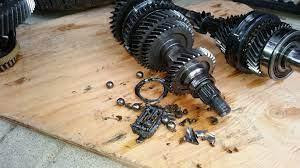Checking the engine oil and filling the windshield washer fluid are pretty easy tasks for most vehicle owners. Topping off the coolant is fairly common, too. How about checking the transmission fluid to see if it is low? As the largest component in a vehicle other than the engine, it would seem like an obvious thing to check. Yet, that is something vehicle owners rarely do.
Numerous good habits of transmission maintenance are related to checking and maintaining the fluid. The most important thing to remember is not to ignore early warning signs of a problem. No matter how minor they may seem, it’s always better if you have it checked out promptly. Transmission problems never go away; they only get worse and a lot more expensive when ignored.

Low transmission fluid symptoms range from system alerts like a check engine light to slipping gears. Let’s look at a few indicators that your transmission fluid might be low:
Check Engine Light On
The check engine light comes on to let the driver know that there is a problem in one of the vehicle’s systems. A trouble code or dash light does not necessarily mean the transmission fluid is low, but a low transmission fluid level will cause the check engine light to illuminate on most modern vehicles. If the light comes on, get your vehicle into a repair facility as soon as you can to get a proper diagnosis. At a minimum, you should get a handy OBD2 scan tool to identify if the code is related to the transmission.
Transmission Overheating
One of the primary functions of transmission fluid is to help dissipate heat inside of the transmission. If the fluid is low, heat will start to build up quickly. Simply put, when there is less fluid doing the work to manage heat, the overheating transmission causes parts to wear down faster and fluids to break down. It doesn’t take much heat to cause serious damage inside of the transmission. Many vehicles have a warning light to let you know that your transmission is overheating, and you should make sure you get a transmission over-temp light checked out as soon as possible!

Burning Smell
Another sign of a low transmission fluid level is a burning smell coming from the transmission. As heat builds inside the transmission, it starts to cause the various soft parts (e.g., clutches or seals) to degrade and break down. The smell of something burning should be treated very seriously since it is an indication that damage is occurring inside the transmission right now!
Transmission Leaks
A transmission fluid leak is a symptom of low transmission fluid that is generally easy to spot. The fluid is bright red with a sweet smell and will be visible on the surface underneath your car and in the engine compartment. If the leaking fluid is dark in color and smells burnt, you may have a bigger problem than you want. Burnt fluid can be caused by low transmission fluid levels, and what fluid remains is made to work harder than normal. Also, when there is a breakdown of soft or hard components in a transmission, it contaminates the transmission fluid, making it less productive.

Delayed Shifting
Automatic transmissions are hydraulic systems that use transmission fluid to help shift between gears. When the fluid gets low, the driver will often feel a hesitation as the transmission is trying to shift from one gear to another. You might also put the vehicle into “drive” or “reverse” and find that it takes a couple of seconds for the vehicle to engage and move. This can be a red flag, and you should have a specialist evaluate your transmission performance. Keep in mind that transmission performance can change when it gets to the operating temperature. Just because the vehicle runs properly after a cold start does not mean it will operate as designed after 30 minutes. Traffic and heat are two of the greatest enemies of transmission performance, so be observant of your vehicle’s shifting behavior on a hot day while sitting in stop-and-go traffic.
Slipping Between Gears
As with a delayed shift, a low transmission fluid condition can cause the transmission to slip between gears. Slipping between gears is one of the worst things that can happen when transmission fluid is low. When this occurs, you will see the engine revolutions continue to increase, but the vehicle won’t increase speed. This is a sign that the transmission is having trouble getting out of one gear and shifting into another.
Grinding

Transmission fluid acts as a lubricant for the various hard parts inside of the transmission. If the fluid gets low, this allows many of the metal parts to make contact without proper lubrication. This creates friction and heat, and these metal parts will start to grind as they begin to experience damage. Again, sounds like this should not be ignored because it’s an obvious sign of a transmission issue. You don’t want to be surprised with a vehicle breakdown at the most inopportune moment!
Vehicle Doesn’t Move
As mentioned above, an automatic transmission is a hydraulic system and requires transmission fluid to operate correctly. When the fluid gets low enough, you might find that the vehicle simply won’t move. If you put your vehicle into drive or reverse and nothing happens, this could be an unfortunate sign that your transmission fluid has gotten low enough that the transmission has stopped working.
How Much Transmission Fluid to Add if Low
Transmission fluid is essential for the proper functioning of your vehicle’s transmission. It lubricates, cools, and powers the transmission’s internal components. If the fluid is low, it can lead to a variety of problems, including erratic shifting, overheating, and even transmission failure.
Here’s a step-by-step guide on how to check and determine the proper transmission fluid level and which fluid to use:
Checking Transmission Fluid Level:
- Vehicle Preparation:
- Start the vehicle and let it reach its normal operating temperature.
- Place it in ‘Park’ or ‘Neutral’ mode and ensure the emergency brake is on.
- Let the engine run. Some vehicles require the engine to be running to check the fluid, while others don’t. Refer to your owner’s manual for specific guidance.
- Locate the Dipstick:
- In many vehicles, the transmission fluid dipstick is located near the engine’s oil dipstick, but its appearance can differ. Sometimes it’s labeled. If you’re unsure, refer to your vehicle’s manual to locate it.
- Check the Fluid:
- Pull out the dipstick, wipe it clean with a lint-free cloth, and reinsert it fully.
- Pull it out again and examine the fluid level. There should be two marks on the dipstick, usually labeled “hot” and “cold.” Your fluid level should be between these two marks. If the engine is warm, you’ll want to check it against the “hot” mark.
- Also, note the fluid’s color. Good transmission fluid is usually a clear reddish-brown color. If it’s very dark or has a burnt smell, it might be time for a change.
Determining How Much Fluid to Add:
If the fluid level is below the “cold” or “hot” mark:
- Small Additions:
- Start by adding a half-quart of the recommended fluid. It’s better to add in small amounts rather than overfilling. Overfilling can cause the fluid to foam, which can lead to erratic shifting and damage to the transmission.
- Recheck the Level:
- After adding, reinsert the dipstick, wait a moment, then check again. Repeat this process until the fluid level is between the “cold” and “hot” marks.
Choosing the Right Transmission Fluid:
- Refer to Your Owner’s Manual:
- Always use the type of transmission fluid recommended in your vehicle’s owner’s manual. There are different types of transmission fluids, and using the wrong one can damage your transmission.
- Automatic vs. Manual:
- Automatic and manual transmissions usually require different fluids. Ensure you’re buying the correct fluid for your type of transmission.
- Brands and Specifications:
- Some vehicles require specific brands or specifications of fluid, especially newer or high-performance vehicles. It’s vital to follow these recommendations.
Ensuring the proper transmission fluid level is crucial for your vehicle’s optimal performance and longevity. Always refer to your vehicle’s owner’s manual for specific details on checking and adding fluid. If you’re ever in doubt, it’s best to consult with a transmission specialist.
Come to the Transmission Specialists
When there are signs your transmission fluid is low, it’s important to correctly check your vehicle’s transmission fluid level. Many quick lube facilities don’t have the tools or the training to check the fluid level of modern automobiles. If you want to have your fluid level checked and make sure your vehicle is working the way that it should, contact Advanced Transmission Center at either of our locations, and we’d be happy to help! Unlike dealerships or many independent repair shops, we are driveline specialists trained to fix issues related to a vehicle’s 2-wheel drive, 4-wheel drive, and all-wheel drive systems. You can reach out to either location that is most convenient for you.
Advanced Transmission Center – Lakewood
1194 S. Pierce St
Lakewood, CO 80232
PHONE: (303) 922-4102
Advanced Transmission Center – Westminster
3686 W. 72nd Ave
Westminster, CO 80030
PHONE: (303) 421-4140
Please give us a call or send us a message ASAP. We look forward to serving your vehicle drivetrain and transmission needs. Across five decades, our goal remains to be “Geared for Customer Satisfaction!”
Advanced Transmission Center is a Colorado-owned and operated auto repair shop with locations in Denver / Lakewood and Westminster. ATC specializes in driveline issues such as automatic transmission repair, four wheel drive repair, clutch replacement, differentials, manual transmissions and CVT. As Colorado's first AAA approved shop our goal is to provide accurate, timely service with exceptional customer satisfaction. All of our technicians are certified in the latest makes and models and we are one of the few transmission repair shops with a nationwide warranty.



 Free Customer Towing Service
Free Customer Towing Service  Free TrueTest™ Inspection
Free TrueTest™ Inspection  Fast Transmission Services
Fast Transmission Services  Comprehensive Warranty in Denver
Comprehensive Warranty in Denver 


























Pingback: What is a Sealed Transmission? (What To Know)